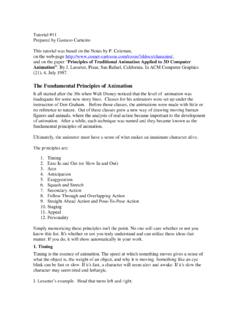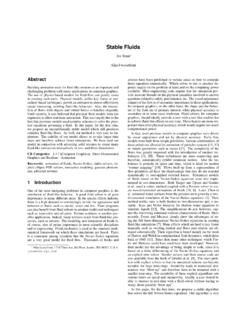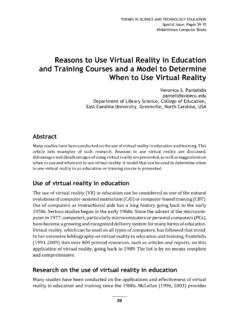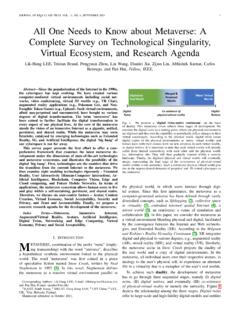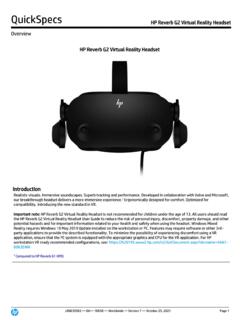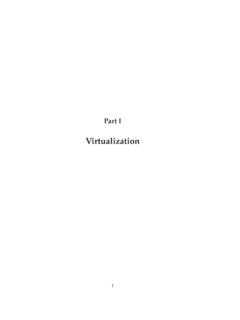Transcription of Real-Time Fluid Dynamics for Games - Dynamic Graphics …
1 Real-Time Fluid Dynamics for Games Jos Stam Alias | wavefront 210 King Street East Toronto, Ontario, Canada M5A 1J7 Email: Url: Abstract In this paper we present a simple and rapid implementation of a Fluid Dynamics solver for game engines. Our tools can greatly enhance Games by providing realistic Fluid -like effects such as swirling smoke past a moving character. The potential applications are endless. Our algorithms are based on the physical equations of Fluid flow, namely the Navier-Stokes equations. These equations are notoriously hard to solve when strict physical accuracy is of prime importance. Our solvers on the other hand are geared towards visual quality.
2 Our emphasis is on stability and speed, which means that our simulations can be advanced with arbitrary time steps. We also demonstrate that our solvers are easy to code by providing a complete C code implementation in this paper. Our algorithms run in Real-Time for reasonable grid sizes in both two and three dimensions on standard PC hardware, as demonstrated during the presentation of this paper at the conference. Introduction Fluid flows are everywhere: from rising smoke, clouds and mist to the flow of rivers and oceans. Because one of the major goals of Games is to immerse players into plausible virtual worlds, it is desirable to include Fluid flows into game engines.
3 There already exist many ad-hoc models that attempt to fake Fluid -like effects, such as particles rendered as textured sprites. However, animating them in a convincing manner is not easy. We believe that a better alternative is to use the physics of Fluid flows which have been developed since the time of Euler, Navier and Stokes (from the 1750 s to the 1850 s). These developments have led to the so-called Navier-Stokes Equations, a precise mathematical model for most Fluid flows occurring in Nature. These equations, however, only admit analytical solutions in very simple cases. No progress was therefore made until the 1950 s when researchers started to use computers and develop numerical algorithms to solve the equations.
4 In general, these algorithms strive for accuracy and are fairly complex and time consuming. This is because the applications that require these solvers have to be physically accurate. It is obviously crucial that the stresses and drag on an airplane or a bridge are calculated precisely. In computer Graphics and in Games on the other hand what matters most is that the simulations both look convincing and are fast. In addition it is important that the solvers aren t too complex so that they can be implemented on standard PCs, game consoles or PDAs. In this paper we present a set of algorithms which meet these requirements. To achieve these goals we depart from conventional wisdom in computational physics and develop algorithms custom tailored for creating visual effects.
5 Unlike physically accurate solvers which have strict bounds on their time steps, our algorithms are stable, and never blow up. The Physics of Fluids Figure 1: The Navier-Stokes Equations for the velocity in a compact vector notation (top) and the equation for a density moving through the velocity field (bottom). Mathematically, the state of a Fluid at a given instant of time is modeled as a velocity vector field: a function that assigns a velocity vector to every point in space. Imagine the air that occupies a room, its velocity will vary due to the presence of heat sources, air drafts, etc. For example, the velocity of the air near a radiator will predominantly be pointing in the upward direction due to heat rising.
6 The distribution of velocities within a room is also quite complex as is evident when watching the smoke rising from a cigarette or the motion of dust particles in the Navier-Stokes Equations are a precise description of the evolution of a velocity field over time . Given the current state of the velocity and a current set of forces, the equations tell us precisely how the velocity will change over an infinitesimal time step. Figure 1 (top) depicts these equations in a compact vector-like notation. Very roughly the equation states that the change in velocity is due to the three terms on the right hand side of the equal sign. A velocity field on its own isn t really visually interesting until it starts moving objects such as smoke particles, dust or leaves.
7 The motion of these objects is computed by converting the velocities surrounding the object into body forces. Light objects such as dust are usually just carried along with the velocity field: they simply follow the velocity. In the case of smoke, it is prohibitively expensive to model every particle. Hence in this case the smoke particles are replaced by a smoke density: a continuous function which for every point in space tells us the amount of dust particles present. The density usually takes values between zero and one: where there is no smoke the density is zero, and elsewhere it indicates the amount of particles present. The evolution of the density field through the velocity field of the Fluid can also be described by a precise mathematical equation, which is depicted at the bottom of Figure 1.
8 The reader is not expected to fully understand these equations. However, it should be evident to anyone that the two equations in Figure 1 look very much alike. In fact, this resemblance was instrumental in the development of our algorithms. The equation for the density (bottom) is in fact simpler than the one for the velocity (top). The technical reason is that the former is linear while the latter is non-linear. We first developed an algorithm for the density moving through a fixed velocity field and then realized we could apply it to compute the evolution of the velocity field as well. In this paper we will follow this historical development. First we will show how to solve the density equation.
9 This will familiarize the reader with the different components of our solver. The concepts involved are also easier to explain and visualize. Subsequently we will transfer these ideas to the harder problem of simulating velocity fields. A Fluid in a Box N+1NN-1210012N-1NN+1 Figure 2: Computational grids considered in this paper. Both the density and the velocity are defined at the cell centers. The grid contains an extra layer of cells to account for the boundary conditions. Mathematical equations for fluids are useful when thinking about fluids in general. However, in practice we need a finite representation for our fluids. The usual approach is to dice up a finite region of space into identical cells and sample the Fluid at each cell s center.
10 In this paper for the sake of clarity we will only describe a Fluid living in two dimensions. However, extensions to three dimensions of everything stated in this paper are straightforward. Nothing in this paper is restricted to two dimensions. Therefore, our Fluid will be modeled on a square grid like the one shown in Figure 2. We allocate an additional layer of grid cells around the Fluid s domain to simplify the treatment of the boundaries. Both the velocity and the density are assumed to be constant in each grid cell and we usually display their values at the cell center. In practice we allocate two arrays for both the density and the velocity of size, size=(N+2)*(N+2): static u[size], v[size], u_prev[size], v_prev[size]; static dens[size], dens_prev[size]; We prefer to use single dimensional arrays over double ones for efficiency purposes.




